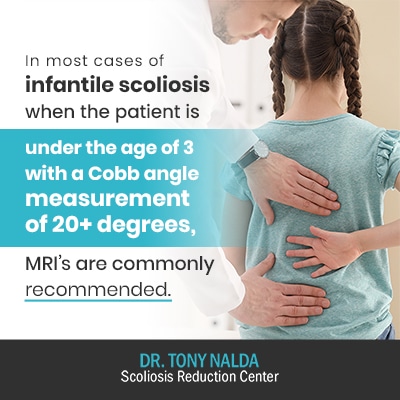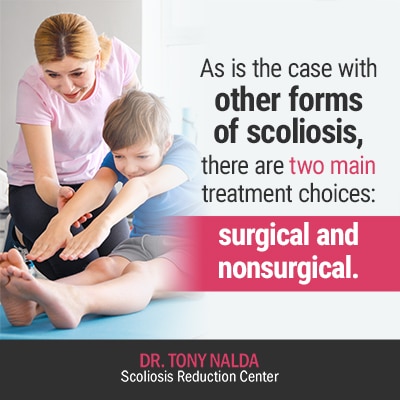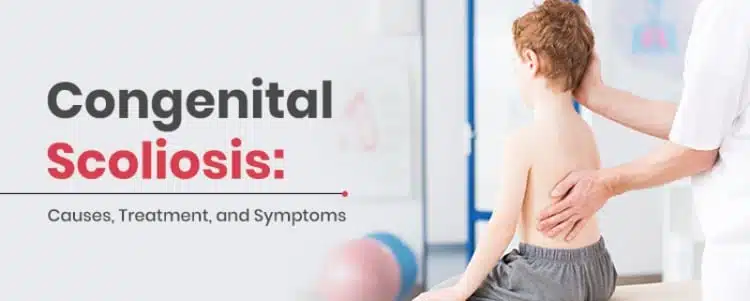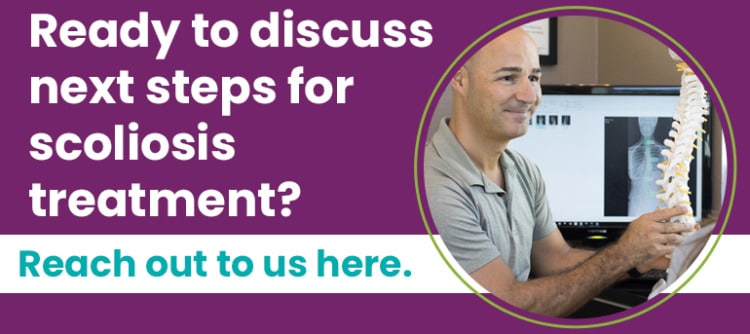There are many different types of scoliosis a person can develop. The condition can affect any age and develops irrespective of gender, race, and socioeconomic factors. A condition’s cause, when known, helps classify the condition. Congenital scoliosis is one of the less typical condition forms with a known cause.
Congenital scoliosis is the presence of an abnormal spinal curvature that affects newborns and/or young infants. Sometimes referred to as ‘infantile scoliosis’, when scoliosis is congenital, the abnormal spinal curvature develops in utero. The curvature makes the spine bend to the left or right, in the shape of an ‘S’ or a ‘C’.
While scoliosis is most commonly diagnosed in adolescents between the ages of 10 and 18, younger children and infants can develop the condition too. Infants with congenital scoliosis often have other medical issues such as bladder or kidney problems.
Understanding Congenital Scoliosis
Congenital scoliosis is a complex condition that affects the spine, causing an abnormal curvature that can lead to a range of physical and emotional challenges. This spinal deformity develops in utero, meaning it is present at birth, and can vary significantly in severity. For children with congenital scoliosis, the abnormal spinal curvature can impact their daily lives, from physical activities to emotional well-being. Early detection and treatment are crucial in managing the condition effectively. Pediatric spine surgeons play a vital role in diagnosing and treating congenital scoliosis, helping to mitigate the impact on the child’s spine and overall health. Understanding the condition, its causes, symptoms, and treatment options is essential for providing the best possible care and support for congenital scoliosis patients.
Scoliosis and Babies
When scoliosis is diagnosed in children under the age of 10, this is often referred to as ‘early-onset scoliosis’. Within that group, the youngest cases involving children under the age of 3 are further categorized as ‘infantile scoliosis’.
In cases of infantile scoliosis with small curvatures, it’s possible that the abnormal spinal curvature will self-correct without treatment. While some cases of infantile scoliosis resolve themselves by the age of 3, others can progress with maturity, and of course, there is no definitive means of predicting which cases will get worse, and which will improve on their own.
Monitoring curve progression in infantile scoliosis is crucial. Regular X-rays are essential to track changes in the curve, as some curves may remain stable while others can worsen as the child grows.
It is very important to understand that even though some cases of infantile scoliosis resolve without treatment, in those that do not, they are facing a higher chance of progressing to severe levels and causing issues later in life.

Infantile scoliosis is often related to other disorders. In most cases of infantile scoliosis when the patient is under the age of 3 with a Cobb angle measurement of 20+ degrees, MRI’s are commonly recommended.
Congenital Scoliosis in Babies
Scoliosis in patients under the age of 3 is often congenital, meaning its development is due to a bone malformation in the spine that occurred before birth. Congenital scoliosis occurs in approximately 1 in 10,000 newborns and is far less common than adolescent idiopathic scoliosis that accounts for 80 percent of known diagnosed cases.
The spine is made up of individual bones called vertebrae. These bones are stacked on top of one another, separated by intervertebral discs. If you picture the bones of the spine as rectangular in shape, imagine one of those bones is, instead, triangular in shape.
To diagnose congenital scoliosis, early detection is crucial, involving a comprehensive medical history, physical examinations, and diagnostic tests. Early identification can lead to better treatment outcomes and address potential coexisting health issues.
Imagine how one misshapen vertebra could throw off the alignment of the entire spine. In cases of congenital scoliosis where one part of the body did not develop and form properly, it’s not uncommon for there to be other areas or body parts that are also malformed; this is why, in cases of congenital scoliosis, a thorough assessment of all body systems is necessary.
Causes and Risk Factors
Congenital scoliosis is caused by a combination of genetic and environmental factors that affect the development of the spine during fetal development. While the exact causes are not fully understood, research suggests that genetic mutations and chromosomal abnormalities play a significant role. Environmental factors, such as maternal diabetes or obesity, can also contribute to the development of congenital spinal anomalies. Additionally, a family history of scoliosis can increase the likelihood of a child being born with this condition. By understanding these causes and risk factors, healthcare providers can better identify individuals who may be at higher risk and provide early intervention and treatment to manage the spinal curvature effectively.
Types of Congenital Scoliosis
The spine is a complex and important part of human anatomy with three main natural and healthy curvatures characterizing the spine’s three main sections: cervical (neck), thoracic (middle and upper back), and lumbar (lower back).
The spine can develop a number of conditions, and even within a single condition, such as congenital scoliosis, there can be important differences that contribute to the condition’s development.
Incomplete Vertebrae Formation
The spine develops and forms before birth, and if one or more vertebrae don’t form completely, this abnormality is known as a ‘hemivertebra’. When this happens, the spine tends to produce sharp angles, and that angle can get worse as a child develops and grows, affecting the child’s spine significantly.
This abnormality can involve one vertebra or many. When there are multiple hemivertebrae, they can counteract each other, balancing each other out and making the spine more stable.
When the Vertebrae Fail to Separate
As a fetus develops in utero, the spine initially forms as a single column of tissue; later, this column separates into individual segments, becoming vertebrae (bones of the spine). When this separation isn’t complete, a partial fusion can occur, joining two or more vertebrae together as one solid bone (bony bar).
Bony bars of this nature prevent the spine from growing evenly on both sides after the child is born.
Bars and Hemivertebrae Combination
When there is a combination of a hemivertebra on one side of the spine and a bar on the other, this can cause serious growth problems. These types of cases are severe as there are two issues impacting the spine’s health.
Surgery is often recommended at an early age to prevent the spine’s abnormal curvature from increasing.
Compensatory Curves
A child’s spine can develop what’s known as ‘compensatory curves’, in addition to scoliosis curves.
Compensatory curves develop in an effort to maintain a straight and upright posture. This occurs when the body responds to the presence of unnatural scoliosis curves by putting in spinal curves in the opposite direction, either above or below the affected area.
Congenital Scoliosis Symptoms
Most often, congenital scoliosis is diagnosed after a pediatrician notices an abnormality to the back during a routine examination.
As scoliosis in children is not painful, if the condition is not noticed at birth, it can remain undetected until it starts to produce noticeable signs and symptoms. In fact, it’s not uncommon for these conditions to remain undetected until adolescence.
Teenagers noticing that their clothing isn’t fitting properly, or parents noticing something seems wrong when they see their adolescent in a bathing suit is often how these late discoveries are made.
Other physical signs of scoliosis include:
- Tilted and/or uneven shoulders
- One shoulder blade protruding more than the other
- One side of the rib cage protruding more prominently
- An uneven waistline
- One hip sitting higher than the other
- An overall tilting appearance to the body
- Rarely, issues with the spinal cord and/or nerves can produce weakness, numbness, and/or a loss of coordination
Congenital Scoliosis Treatment
When planning a child’s congenital scoliosis treatment plan, their doctor will factor in the type of spinal abnormality, the severity of the curvature, and any other relevant health issues present.
The doctor will gauge how likely it is that the child’s curvature will progress and suggest different treatment options that best address the child’s specific condition and needs. For moderate and severe curves, more intensive interventions like casting and bracing are often necessary, as these cases have a higher likelihood of progression compared to mild curves, which may only require observation.

As is the case with other forms of scoliosis, there are two main treatment choices: surgical and nonsurgical.
Surgical Treatment for Congenital Scoliosis
While every case is different, in most cases, surgical treatment is recommended for patients who have curvatures that are clearly progressing, are particularly severe, have large spinal and/or trunk abnormalities, or are developing a neurological issue due to the spinal cord’s abnormality.
When surgery is the chosen course of treatment, the goal is to let the spine and chest grow as much as possible, and there are multiple different types of spinal surgery:
Spinal fusion: the most-tilted vertebrae are fused together into one solid bone. This will eliminate movement in the affected area, meaning that progression will likely be stopped.
Hemivertebra removal: the removal of a single hemivertebra. This partial correction of the curvature is then further managed with metal implants. The procedure fuses two or three vertebrae together.
Growing rods: growing rods can be lengthened to accommodate a growing spine while working towards correcting a curvature. These rods can be lengthened with minor surgery that’s repeated every six to eight months.
One or two of these rods are attached to the spine above and below the site of the curvature.
Every six to eight months, the rod is lengthened, and when the child is full grown, the rods are replaced, and spinal fusion is performed.
Nonsurgical Treatment for Congenital Scoliosis
Here at the Scoliosis Reduction Center®, our treatment goals for our congenital scoliosis patients are similar to our other patients: reduce the curvature size, prevent further progression, improve function, provide long-term stabilization, and if a patient is going to have surgery, prepare them, and their families, for as positive a surgical outcome as possible.
As there is no reliable method for determining whether an infant’s scoliosis is going to progress or remedy itself, or what their curvature size will be in the future, treatment can be a delicate balance of observation and action.
Once a curvature progresses past 25 degrees, that curvature tends to continue progressing into maturity, if left untreated. When a curvature is small is almost always the best time to act as we can take those proactive steps towards stopping that small curvature from becoming larger.
As growth is the number-one trigger for progression and infants have a lot of growth ahead of them, scoliosis curves can increase as the spine grows.
X-rays are a large component of observing how the spine is responding to treatment. When we are treating infants with scoliosis, there are certainly some unique challenges.
Our treatment plans for infants are customized and specific to each patient. These plans often include modified scoliosis-specific therapy and/or corrective bracing so that any age-specific challenges are addressed.
Congenital scoliosis is an abnormal sideways curvature of the spine that develops due to a spinal abnormality that occurred in utero.
It’s not uncommon for children with congenital scoliosis to have other health issues, which is why a comprehensive assessment of the body’s systems and parts are necessary.
Although congenital scoliosis develops in utero and is present at birth, it’s not uncommon that the condition remains unnoticed until adolescence, when the growth spurts associated with puberty cause further progression and noticeable symptoms.
Complications and Associated Conditions
Congenital scoliosis can lead to a range of complications and associated conditions, making it essential to monitor affected individuals closely. One significant complication is thoracic insufficiency syndrome, a condition that affects lung function due to the abnormal shape of the thoracic spine and rib cage. This can lead to respiratory problems and impact overall health.
Additionally, severe deformity of the spine can cause spinal cord damage, leading to neurological issues such as weakness, numbness, or loss of coordination. Children with congenital scoliosis may also experience other musculoskeletal issues, further complicating their condition.
Early detection and prompt treatment of these complications are crucial for improving the long-term outlook for congenital scoliosis patients.
Long-term Outlook and Prognosis
The long-term outlook and prognosis for individuals with congenital scoliosis vary depending on the severity of the condition, the effectiveness of treatment, and the presence of any associated conditions.
With early detection and appropriate treatment, many individuals with congenital scoliosis can lead active and healthy lives, with minimal limitations on their daily activities. However, those with severe curves or concurrent spinal deformities may face ongoing challenges and require continuous medical care and management.
Personalized treatment plans, developed in collaboration with healthcare providers, are essential for monitoring progress and addressing any complications that arise. By staying proactive and vigilant, individuals with congenital scoliosis can achieve the best possible outcomes.
Coping and Support
Living with congenital scoliosis can be challenging, both physically and emotionally. It is essential to have a strong support system in place, including family, friends, and healthcare providers. Connecting with others who have the condition, either through support groups or online communities, can provide valuable emotional support and practical advice.
Counseling and therapy can also help individuals cope with the emotional and psychological aspects of living with congenital scoliosis, addressing feelings of anxiety, depression, or self-esteem issues.
By providing emotional support and connecting individuals with resources and services, we can help those with congenital scoliosis lead fulfilling and meaningful lives, despite the challenges they may face.





